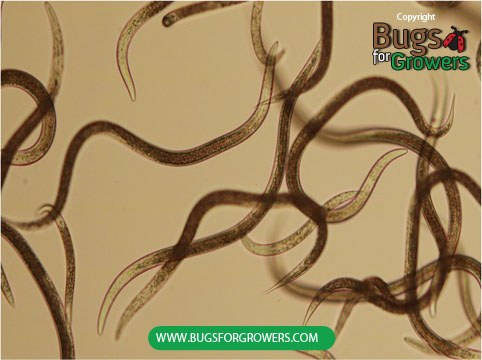Damage caused by strawberry root weevils
Strawberry root weevils (Otiorhynchus ovatus) cause serious damage to strawberries. The adults of strawberry root weevil mostly feed on the edges of strawberry leaves that gives typical notched appearance but their grubs feed by tunnelling the crowns and roots of strawberries. The strawberry root weevils overwinter as grubs in the soil. When temperature warms up early in the spring, these overwintering grubs resume feeding on the strawberry roots and crowns. The most damage is caused from March through June.The main symptoms of damage caused by grubs of strawberry weevils include root pruning, weak and stunted plant growth, and dying of plants. This type of damage reduces the yield of strawberries.
Identification of strawberry root weevils
Adult of the strawberry root weevils are reddish brown to black in color with rows of pits on the forewings. These weevils cannot fly because their forewings are fused together but they can walk very fast and find their host plants.These weevils have long antennae. The strawberry root weevils generally lay small, whitish brown and spherical eggs that hatch into small creamy white colored grubs with tanned brown head capsule. Mature grubs are legless,‘C’ shaped and about 12 mm long. The pupae of the strawberry root weevil are also creamy white in color.
Life cycle of strawberry root weevils
The strawberry root weevils overwinter as grubs in the soil. These overwintering grubs become active when temperature start warming up early in the spring and start feeding on the strawberry roots and crowns again. While feeding, grubs become mature and then pupate in the soil. Adult weevils then emerge from the pupae and start feeding on the strawberry leaves. Females generally lay eggs in cluster at the base of plants in the soil. After hatching from eggs, young grubs continue feeding on the roots until September, then overwinter and life cycle continues. The strawberry root weevils commonly complete one generation in a year.
Biological control of strawberry weevils with Steinernema carpocapsae
Beneficial entomopathogenic nematodes called Steinernema carpocapsae (Photo 1) can be successfully used as alternatives to chemical pesticides for controlling strawberry weevils. Steinernema carpocapsae nematodes are easy to apply and they are known kill both the grubs and pupae of the strawberry weevils within 48 hours after their application. Thus they can stop the emergence of future generation of adults of strawberry weevils.
When Steinernema carpocapsae nematodes are applied on the strawberry beds, they enter in the soil where they search, infect and kill all the soil-dwelling grubs and pupae of strawberry weevils. Steinernema carpocapsae nematodes generally enter into the body cavity of grubs and pupae of strawberry weevils via natural openings like anus, mouth and spiracles. Once in the body cavity, nematodes release symbiotic bacteria called Xenorhabdus nematophila in the blood where th bacteria multiply quickly and cause septicemia and kill grub or pupa within 48 hours of infection. Thus the killing of both larvae and pupae of strawberry weevils by nematodes completely stops the emergence of future generation of adult weevils.

How to apply Steinernema carpocapsae nematodes?
To target both grub and pupal stages of strawberry weevils, use watering can and a knapsack backpack sprayer for spraying nematodes on a small home garden area and on the large areas, respectively. Since nematodes need a film water for their easy movement in the soil, irrigate areas to be treated before and after application of nematodes so that the optimum level of moisture will be maintained in the soil. Also, apply nematodes either early in the morning or late in the evening to avoid their exposure to UV radiation as its short exposure can kill nematodes instantly.
How many Steinernema carpocapsae nematodes should be applied?
The optimum rate for the effective control of fleas is 23,000 Steinernema carpocapsae nematodes per square foot area. Use following table to apply correct numbers of nematodes based on square foot area.
Area in sq. ft. = Number of nematodes required
1sqft = 23,000 nematodes
100 sqft = 2,300,000 nematodes
500 sqft = 11,500,000 nematodes
1,000 sqft = 23,000,000 nematodes
43,560 sqft (1 Acre) = 1,000,000,000 nematodes
